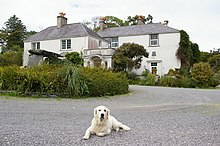Valentia Island
| Valentia Island Dairbhre |
||
|---|---|---|
| Weighing House in Knightstown Harbor | ||
| Waters | Atlantic Ocean | |
| Geographical location | 51 ° 54 ′ N , 10 ° 22 ′ W | |
|
|
||
| length | 11 km | |
| width | 3 km | |
| surface | 26.306 km² | |
| Highest elevation | Geokaun 266 m |
|
| Residents | 665 (2011) 25 inhabitants / km² |
|
| main place | Knightstown | |
| Knightstown Church | ||
Valentia Island ( Irish : Dairbhre or Oileán Dairbhre , English also Valencia Island ) is one of Europe's westernmost inhabited islands . It is located in the southwest of County Kerry in Ireland and has 665 inhabitants (as of 2011). Valentia in Portmagee is connected to the mainland by a bridge ( 51 ° 53 ′ N , 10 ° 22 ′ W ). There is also a ferry service from Reenard Point to Knightstown ( 51 ° 56 ′ N , 10 ° 17 ′ W ), the island's main settlement, between April and September . The island is 11 km long and 3 km wide.
A ring road opens up the island. While the southern, the R565, takes on the traffic, the northern, higher situated leads to the prehistoric monuments ( menhirs , Oghamstones and wedge tombs ). Branches to the west and north coast lead to further places.
Surname
The island's Irish name, Dairbhre , means "oak grove". The English name is a corruption of the Irish place name Béal Inse ("island mouth ") or from Cuan Bhéil Inse ("port of the island mouth", English Valencia Harbor ). The Irish pronunciation of Bhéil Inse is similar to the English pronunciation of the Spanish city of Valencia , so this name was used in English for the entire island.
The garden of Glanleam House
In the northeast of the island is the "Glanleam House" ( Teach Ghleann Laoim ), whose garden has many subtropical plants. Protected from the Atlantic storms by a belt of trees and ridges, this garden has the mildest microclimate in Ireland. In the 1830s, Sir Peter George Fitzgerald, the 19th Knight of Kerry (1808–1880) began to plant the garden. Above all, the unique collection of rare and sensitive plants from the southern hemisphere , which otherwise only thrive in the greenhouse in the British Isles, make this garden so unique. The garden is designed in a naturalistic style with different paths. The plants come from South America, Australia, New Zealand and Japan. There are banana trees , myrtle trees, palm trees and the largest tree fern in Europe. The garden is also remembered with the gold-colored Luma apiculata "Glanleam Gold", which bloomed in this garden for the first time.
Mary's Grotto
Another attraction of the island is the Mariengrotto in a former quarry. From this the slates for the British Houses of Parliament were extracted. In 1993, a geology student discovered fossilized traces of terrestrial vertebrates . The footprints left in the mud had been preserved in the Devonian rocks. About 385 million years ago, a primitive vertebrate walked along a muddy equatorial marshland that now forms south-eastern Ireland, leaving marks like fresh concrete. The imprints were obtained by alluvial sand and turned to stone over time. These prints on Valentia Island are some of the oldest known footprints of life in the country.
Menhir of Glanleam
The menhir of Glanleam stands in the middle of a fort , near Cromwell Point and its lighthouse on one of the northern tips of Valentia Island. The almost rectangular menhir ( English Standing stone - Irish Gallaun ) marked on the OS map is about 3.4 meters high, 1.4 meters wide and 0.4 m thick. It is almost trapezoidal in plan and oriented northeast-southwest. Some packing stones are visible around its base. A 1.5 m long plate leans on its southeast side. The menhir stands upright, although Henriette Georgiana Marcia Chatterton (1806–1876) remarked in 1839 that it was "easy to move". An observation that can substantiate the existence of the supporting plate.
Transatlantic cable
Valentia Island was the eastern end point of the first transatlantic cable , which was first laid in 1857, re-laid in a fully functional manner from 1866 and then used until 1966. The first functional transatlantic cable consisted of an electrically conductive strand of six copper wires wound around a seventh. Three separate layers of gutta-percha , a latex material obtained in Asia, were placed on top for insulation . The connection ran between Valentia Island and Trinity Bay in Newfoundland .
Climate table
| Valentia Island | ||||||||||||||||||||||||||||||||||||||||||||||||
|---|---|---|---|---|---|---|---|---|---|---|---|---|---|---|---|---|---|---|---|---|---|---|---|---|---|---|---|---|---|---|---|---|---|---|---|---|---|---|---|---|---|---|---|---|---|---|---|---|
| Climate diagram | ||||||||||||||||||||||||||||||||||||||||||||||||
| ||||||||||||||||||||||||||||||||||||||||||||||||
|
Monthly average temperatures and rainfall for Valentia Island
Source: wetterkontor.de
|
|||||||||||||||||||||||||||||||||||||||||||||||||||||||||||||||||||||||||||||||||||||||||||||||||||||||||||||||||||||||||||||||||||||||||||||||||||||||||||||||||||||||||||||||||||||||||||||||||||
Cool East's Wedge Tomb is also on the island .
literature
- Ann O'Sullivan, John Sheehan: The Iveragh Peninsula: An archaeological Survey of South Kerry . Cork University Press 1996.
Individual evidence
- ↑ Table No. 11 Population of inhabited Islands off the coast, 2006 and 2011 . In: Central Statistics Office (Ed.): Population Classified by area . Dublin 2012, pp. 132-133 ( online ( memento of October 10, 2012 in the Internet Archive ); PDF; 3.64 MB)
- ↑ lighthouse [1]
- ^ In the two-volume "Rambles in the South of Ireland" p. 265
- ↑ There is near it a remarkable stone, which appears druidical; it is upwards of twelve feet high, and five wide, and is very easily shaken; and yet, though it moves in a high wind, it has resisted storm and tempest, probably for ages






